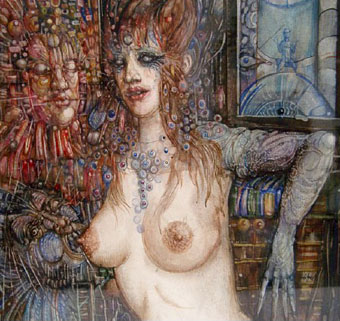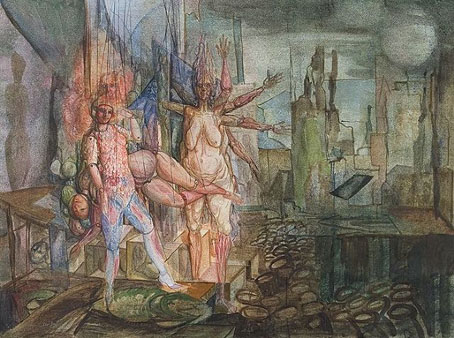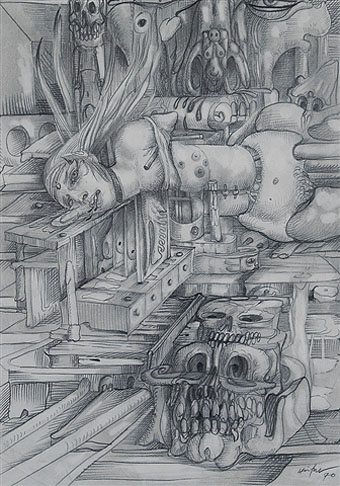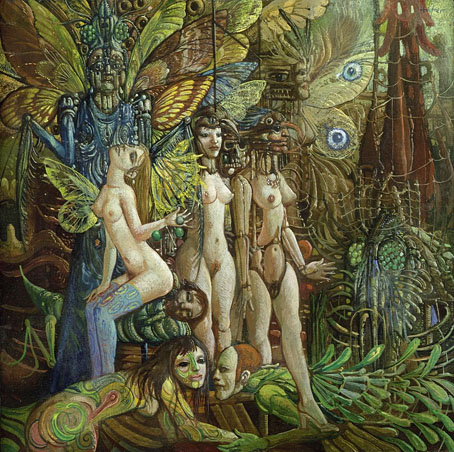The Titan’s Goblet (1833) by Thomas Cole.
Landscape with Grenade (1974) by Cliff McReynolds.
Elsewhere on { feuilleton }
• The fantastic art archive
A journal by artist and designer John Coulthart.
The Titan’s Goblet (1833) by Thomas Cole.
Landscape with Grenade (1974) by Cliff McReynolds.
Elsewhere on { feuilleton }
• The fantastic art archive
Lucifer (no date).
…I find nothing fantastic in so-called fantastic art, it is an aspect of reality in search of sanity beyond the normal bounds. I believe that fantastic art is related to the protective dream, that it prolongs the healing dream and finds symbols that change dread into wonder, strangeness and beauty.
As in all figurative art, fantastic art must of course be judged not only by its intentions but by the quality of the execution, and by standards that have been almost totally lost in the turbulence of changing fashions, movements and politics on the art market. This has led to a noticeable helplessness among the critics, who seem to ignore a growing tendency toward the fantastic in the hope that it will fade away and die. I do not believe it will.
Thomas Häfner
Who was Thomas Häfner? Good question, because he’s virtually invisible on the web. The painting above is scanned from David Larkin’s excellent Fantastic Art (Pan/Ballantine, 1973) and was also used as a cover image for an edition of Blaise Cendrars‘ scurrilous masterpiece, Moravagine. The Demon Woman below is a watercolour original for sale on eBay. Häfner was a member of a group of German artists who called themselves the Young Realists, formed in Düsseldorf in the mid-Fifties. Significantly, another group of young imaginative painters was active at the same time in Vienna, the Fantastic Realists, who included the great Ernst Fuchs among their number. “Realism” here can be considered as referring to a style that favoured the hard-edged realistic approach of Surrealism; Häfner’s content certainly wasn’t realistic.
These people remain neglected or unknown because art critics like to pretend there’s only one story being told in the development of art at any given time when there are usually several, often with conflicting agendas. So we’re always being informed that the dominant movement in fin de siècle Paris was Impressionism and hear little of the Symbolists who were equally—if not more—popular, productive and influential during that period.
(This laziness carries over to other areas; Debussy is continually described as “an Impressionist composer” when one of his most famous works, Prélude à l’après-midi d’un faune, was based on a Symbolist poem by Mallarmé. There are no fauns in Impressionist paintings.)
The prevailing trend in the mid-Fifties was the thin gruel of Abstract Expressionism, the complete antithesis of the kind of art being produced by Häfner, Fuchs and company. There’s a reason for the elevation of this type of work over others. Critics such as Clement Greenberg saw abstraction (which, ironically, grew out of Surrealism) as being a politically acceptable direction after the turmoil of the Second World War. The Nazis liked realism in their art, while the Soviets under Stalin and the Chinese under Mao had declared Socialist Realism to be the official art of the Communist Revolution, therefore realism of any variety was reactionary and bad. Further irony comes when the CIA agreed with this argument and secretly promoted Abstract Expressionism outside America. This has led us to the situation we have today where a Willem de Kooning painting, Woman III (1952–53), was recently sold for $137.5 million which means collecting this kind of work is now a game for billionaires. It really would be the final irony if the kind of realistic art that Clement Greenberg despised was elevated to a new popularity by over-priced Abstract Expressionism as collectors with fewer assets were forced to look elsewhere. Critics can protest all they like but these days it’s money that speaks with the loudest voice in the world of art.

Demon Woman (no date).
Update: added some additional works:

Marionetten (1964).

Szene mit Schädeln (1970).

Phantastische Waldszene (1971).

Masken in zerfallener Umgebung (1974).

Die Harpye (no date).
Elsewhere on { feuilleton }
• The fantastic art archive

In which the lovable moptops get the official mashup treatment courtesy of George Martin’s son, Giles. Very creditable it sounds to these ears although it strains a bit much in places to shoehorn tiny bits of the very familiar songs into other very familiar songs. The added sound effects are pretty superfluous, some of them are probably only there for the multi-channel DVD mix.
The Beatles are where my music listening began, thanks to a mother who was a fan for a while (until they started taking drugs and weirding out), and I can never quite forget this when I listen to them. As with all mashups, it’s the juxtaposition that fascinates, the moment when you think, “wow, song A fits really well with song B!”. So Strawberry Fields Forever ends with Piggies and the end of Hello Goodbye running together, while Within You, Without You really benefits from the addition of the drums from Tomorrow Never Knows. And the sound is fantastic, serving to highlight once more EMI’s disgraceful refusal to properly remaster these albums. I like the cover, a successful combination of the youthful exuberance of the Hard Day’s Night band with the later psychedelic period.
I keep wondering if this is the future of these cultural monuments. Just as Shakespeare’s plays are given new life by fresh interpretation, further reappraisal would help revitalise some of those stale back catalogues. The problem, of course, is that the whole question of copyright has been getting worse in recent years. Much as I’d like to see EMI’s vaults thrown open to sound collagists like John Oswald or Holger Czukay, it isn’t going to happen, is it?
1 “Because”
2 “Get Back”
3 “Glass Onion”
4 “Eleanor Rigby” / “Julia” (transition)
5 “I Am the Walrus”
6 “I Want to Hold Your Hand”
7 “Drive My Car” / “The Word” / “What You’re Doing”
8 “Gnik Nus”
9 “Something” / “Blue Jay Way” (transition)
10 “Being for the Benefit of Mr. Kite!” / “I Want You (She’s So Heavy)” / “Helter Skelter”
11 “Help!”
12 “Blackbird” / “Yesterday”
13 “Strawberry Fields Forever”
14 “Within You Without You” / “Tomorrow Never Knows”
15 “Lucy in the Sky with Diamonds”
16 “Octopus’s Garden”
17 “Lady Madonna”
18 “Here Comes the Sun” / “The Inner Light” (transition)
19 “Come Together” / “Dear Prudence” / “Cry Baby Cry” (transition)
20 “Revolution”
21 “Back in the USSR”
22 “While My Guitar Gently Weeps”
23 “A Day in the Life”
24 “Hey Jude”
25 “Sgt. Pepper’s Lonely Hearts Club Band (Reprise)”
26 “All You Need Is Love”
I don’t use customised folder or desktop icons much these days but this set, entitled Ink, is great, based on tribal tattoo stylings. If there were other designs as good as this in the world of lurid, gum-drop-shaped, drop-shadowed reflectiveness, I might be more inclined to customise my folders now and then. Jamie McCanless is the artist responsible and you can see these and other designs on his site, including some nice GLBT and Pride-themed works.
PS: these are Mac-only.